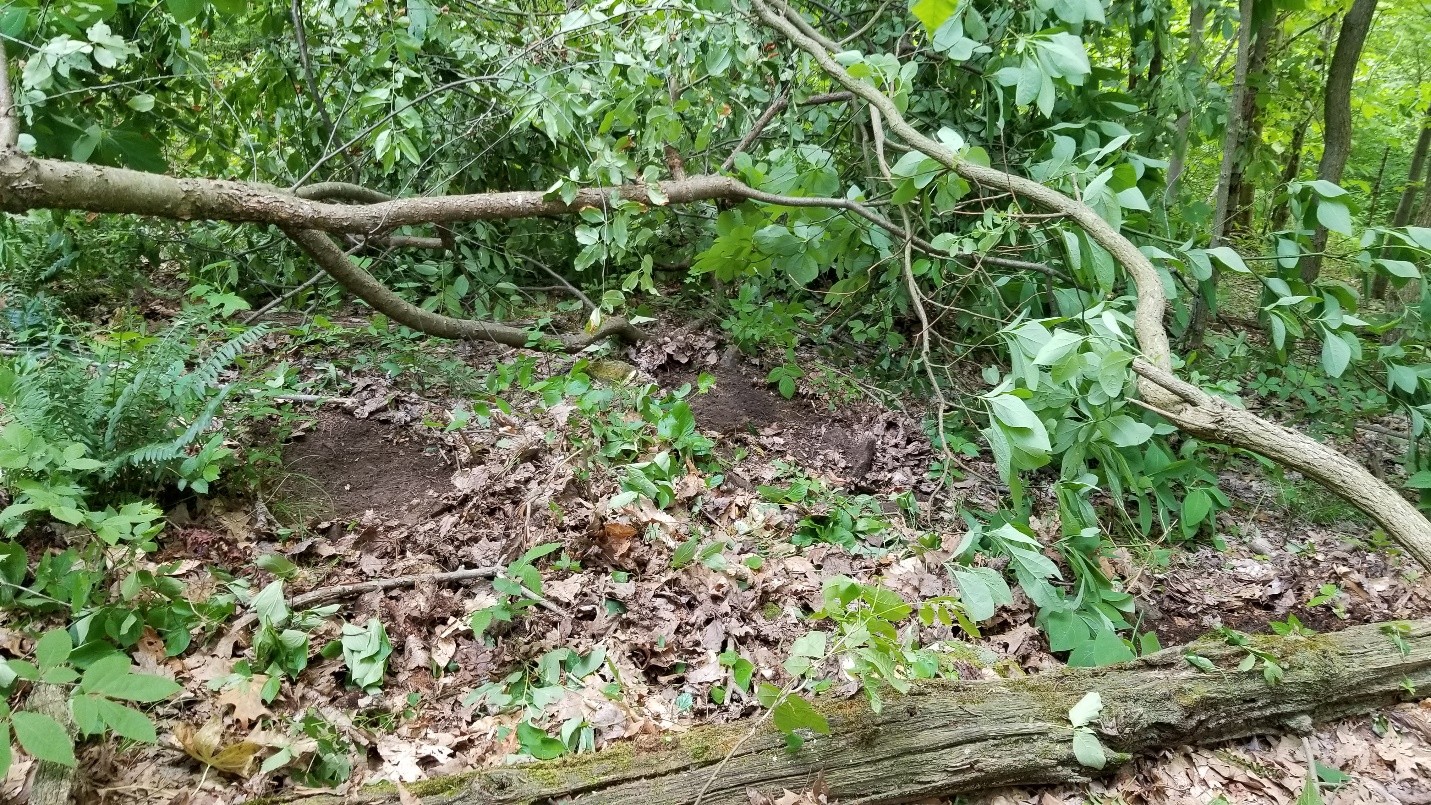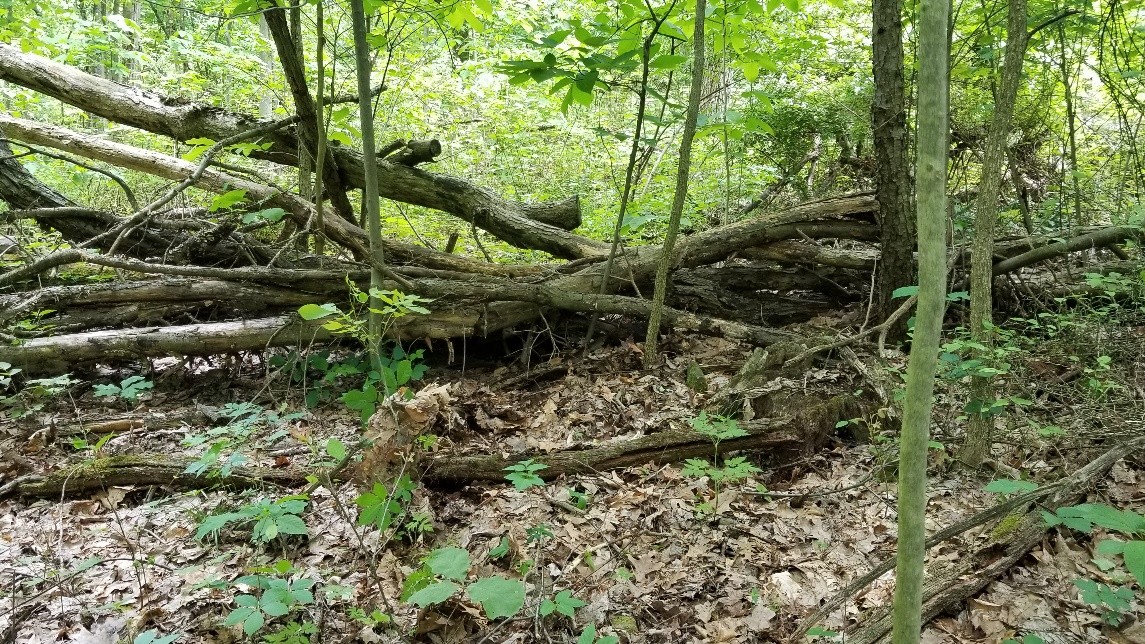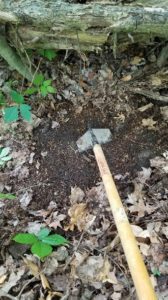Creating Deer Bedding Area
Kenny Miller

Creating deer bedding areas will do a lot to hold deer that you have attracted to your property with food sources, and it will also give deer that are passing through an incentive to stay.
Here’s an example of how we used this method with success. We had one particular area in our property, where we were able to increase the amount of deer it held substantially after we created some bedding area.
In this specific area, there’s a long ridge with an open field on top and a thin line of woods on both sides. About one hundred fifty yards away, there was timber with a lot of brush overgrowth. There were several logging trails the foresters had used going from the thicker timber up to the ridge top field, and the deer used these trails occasionally, but they were only passing through.
We hunted this particular ridgetop a dozen times the first couple years after we acquired the property, and we would occasionally have a couple of bucks cruising the ridgeline in the rut. Still, just as often as not, you didn’t see a single deer on those hunts.
We decided we needed to do something to maximize the potential of this area. Here is the two-step process we used for incredible results.
First, we put a food plot in the open field on the ridge top to attract the deer, but we needed to do something to hold the deer once we got them there.
Here is where creating doe bedding areas came in.
We started by cutting several paths through the overgrowth in the thicker timber one hundred and fifty yards away from the ridgetop food plot. Once we cleared out the paths, until the overgrowth opened up into more open spaces within the timber, we started making doe bedding areas.
We made bedding areas against big rocks, blown down treetops, thickets, and big logs. We made over twenty-five beds in a one-hundred-yard circle. We then cleared more paths connecting three logging trails with that specific bedding area. Doing this gave the deer a couple of different avenues of escape and let more deer find the beds as they started using the trails we cut as shortcuts to the food source. I remember being excited when I went to check a couple of the beds about two weeks after we made them. I found a couple of them being used already, evident by the hair left in the beds.
After we had established the food plot and bedding areas, we saw deer every hunt and often up to a dozen or more. We have had the same does and small bucks stay in that area for the three years since we finished that project.
There is no bedding for mature bucks directly in that area. However, as you can imagine, with the amount of does we can hold there, mature bucks start cruising that area when the rut starts up, and we have had some action-packed days in those stand locations.
You might ask, “What is the difference between a doe bedding area and buck bedding area?” I will explain.
Does tend to bed in groups and will be more likely to bed anywhere that has a little bit of cover.
Mature bucks prefer to bed in the higher elevation of whatever area they are staying in. This tends to be on the end of ridge tops, on a bench, or in the swamplands, it can be on a dry hump that rises a couple of feet higher than the surrounding area. Mature bucks need the advantages of sight, smell, hearing, and multiple avenues of escape before they are comfortable bedding in that area.
These are some of the things to keep in mind when you are strategizing where you want to make deer bedding areas. Also, keep your entry points and prevailing winds in mind when coming up with locations for the bedding areas. You don’t want to have deer bed too close to your entry points, or you will jump them every time you head for your stand. Doing this will either turn your deer nocturnal or, even worse, drive them out of the area.
The same thing applies with your scent. If the wind from your stand location is blowing your scent directly towards the bedding areas, you will see less deer during daylight hours, and you may drive them out of the area.
Doe Bedding Areas
Does are willing to bed anywhere on the property that offers a bit more cover than the surrounding terrain.
They also tend to bed together, so make multiple beds in the same area. They can be as close as a foot or two apart.

You can create doe bedding in tall grasses, against thickets, blowdowns, big rocks, logs, and along benches.
Make sure the bedding areas are in a well-drained area. Deer will not bed in wet soil if they have any other options. Also, avoid extremely rocky areas when possible. It will make your life easier if you don’t have to clear a lot of rocks from the beds.
If you have open timber, make bedding areas against blowdowns or fallen logs that are at least fourteen inches in diameter.
 Another great option is hinge cutting several low-value trees (three to eight inches in diameter), so their tops end up landing together and creating cover and browse for the deer. You can also completely cut down the trees, but hinge cutting will allow the tree to live and will continue to grow leaves, providing additional cover and browse for the deer.
Another great option is hinge cutting several low-value trees (three to eight inches in diameter), so their tops end up landing together and creating cover and browse for the deer. You can also completely cut down the trees, but hinge cutting will allow the tree to live and will continue to grow leaves, providing additional cover and browse for the deer.
Hinge cut by cutting halfway to three-quarters of the way through the tree on the opposite side of where you want your tree to land. Make your cut from three to five feet up the tree trunk.
Use the proper safety equipment when cutting down trees!
Once you have established where you want to make your doe beds, make sure there are paths to that area and paths going from that area. Deer want more than one escape route before they are comfortable using that bedding area.
 Next, you want to clear a three feet by three feet area until you are down to the dirt. I use a garden hoe or rake for this, and it works great. Then clear all the rocks, roots, twigs, and other debris from the bed. No twigs bigger than a pencil should be left in the bed.
Next, you want to clear a three feet by three feet area until you are down to the dirt. I use a garden hoe or rake for this, and it works great. Then clear all the rocks, roots, twigs, and other debris from the bed. No twigs bigger than a pencil should be left in the bed.
Deer will use these beds with twigs and rocks in them if there are no other options. However, think of it like this, would you rather sleep at a clean, luxurious 5-star hotel or a questionable 2-star hotel? If you have the 5-star hotel and your neighboring property has the 2- star hotel, guess where the deer will bed?
Buck Bedding Areas
For buck bedding areas, you want to use a little more strategy. Like I mentioned before, they want the advantages of sight, smell, hearing, and multiple avenues of escape.
You can walk your property or use topographic maps to identify these areas on your property. Look for anywhere that has a higher elevation than its surroundings.
Make sure you keep in mind stand location, entry points, and prevailing wind directions. If a mature buck senses you are in his area, chances are he will not move in daylight hours, or he will completely move out of the area.
It is a good idea to have your buck beds be in a secluded area on your property that doesn’t get a lot of human presence. There are times when it is beneficial to be bold and make a move on a certain bucks bedding area, but as a rule, it is better to hunt that buck away from his bedding area.
Mature bucks will bed alone, so only make one bed in that specific area. Keep buck bedding areas far enough apart so they will not have a sightline from one buck bed to the other. Use the same process of building the buck bed as you did with the doe beds.
In summary.
Creating deer bedding areas is part of a one-two punch (along with establishing food plots), that I like to use when we have a new property. It is a great way to attract and hold more deer instantly.
I hope I was able to show some insight into what it takes to create these bedding areas. You can improve your property quite a bit with only a couple of days of your time and some sweat equity.
Thank you for giving me your time and following along. Good luck this season and every season!
Some questions we get asked.
When are the best times to make deer bedding areas?
We like to start making our deer bedding areas as soon as the hunting season is over up until early summer. We want to give our property a chance to settle down and allow the deer to find the beds before the season starts.
You can, however, make deer bedding areas any time of the year. Try to minimize your intrusion by finishing all the beds in a particular area on the same day. It also helps if you can do it before a forecasted rain. The rain will eliminate the scent you left behind.
How close to food sources should I make bedding areas?
This will vary based on the terrain of your property. However, a good rule of thumb is, have your bedding area be one hundred fifty to two hundred yards away from your food sources. Doing this allows you to have access to your food source stand locations without alerting the deer of your presence.
You can have bedding areas closer if, for example, you have a ridge top between your food source and the bedding area.
Do I need deer bedding areas on your property?
The short answer is no; you don’t need bedding areas on your property. Deer have made it thousands of years finding their own natural bedding.
However, in my experience creating bedding areas on parts of a property that didn’t have any initially will increase the amount of deer you hold in that area.
